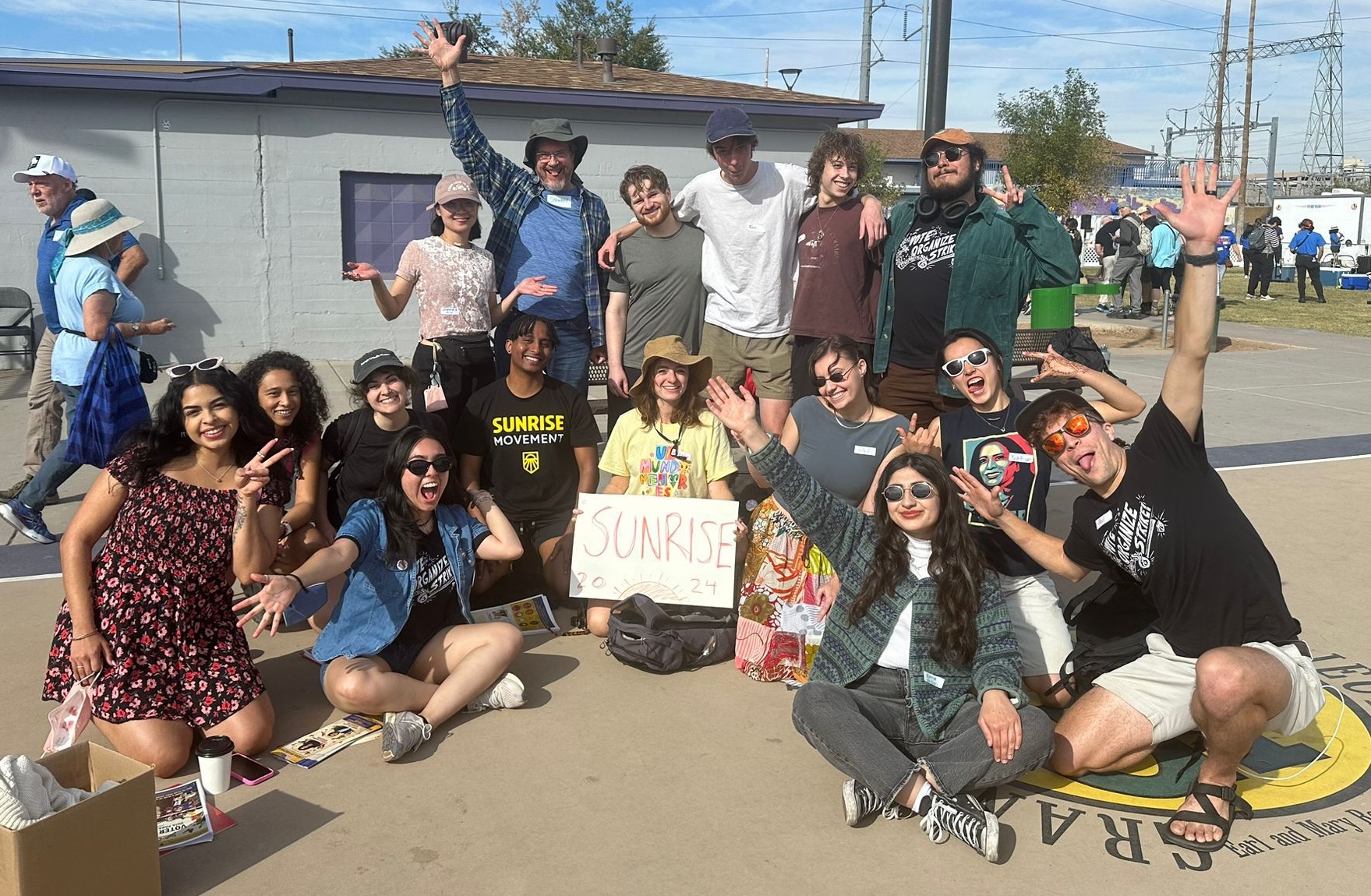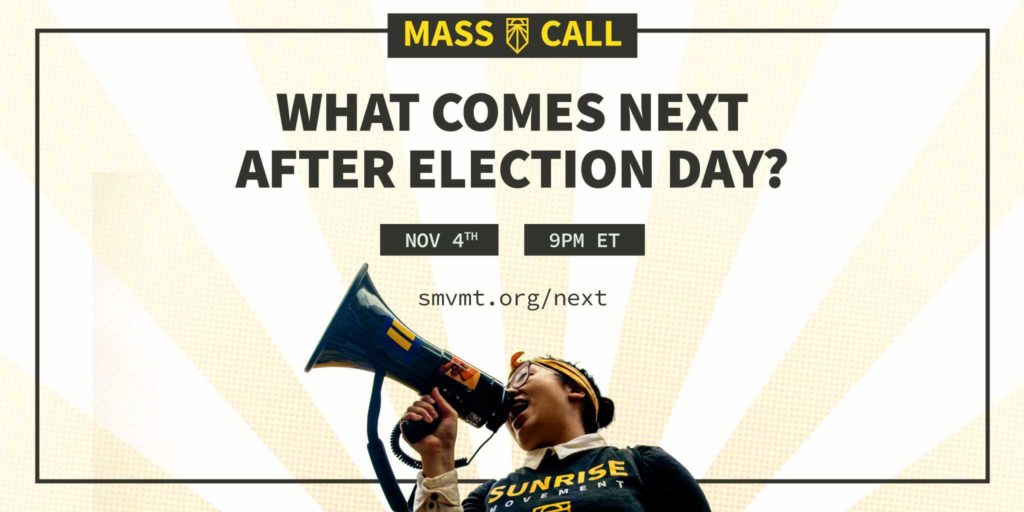We know that to win the Green New Deal, we have to become a movement of millions — and that we grow the movement by talking with our friends, families, and communities. 40% of voters don’t even know what the Green New Deal is — and that number is likely to be lower when non-voters are factored in. In-person conversations have been proven to change political attitudes, so our role as messengers is crucial to our success!
Talking to our families about politics can be scary, so we put together a conversational guide to help you confidently discuss climate change and the GND, no matter how comfortable your family is with talking about them. At the end of the day you know your family best, so feel free to adapt and run with these suggestions!
Step 1: Open the conversation.
So you’re just sitting down to dinner with your family for the holidays. It’s the first time you’ve seen Auntie Z in months, and after asking about school or work, you’d like to talk about all the organizing you’re doing with Sunrise. If your organizing with Sunrise hasn’t come up in your conversation and you want to introduce it, start by catching up with Aunt Z about her job, her kids, or what she’s been reading or watching lately. Union organizers call this “showtime” — a few moments to engage with your conversational partner about their life and yours, before launching into a more structured discussion.
Don’t jump right into a blow-by-blow pitch for a new decarbonized economy, or describe the need for reparations from the Global North to the Global South — unless Aunt Z is already pretty down, you’ll risk overwhelming her or failing to connect before conversation has even begun. Save those talking points for later.
Step 2: “Read the room”- get a handle on what’s going on in your Aunt’s community
No matter what your Aunt currently thinks about the climate crisis, there are probably some changes that she’d like to see in the economic, social, and political order. Understanding what those changes are is the first step to moving them to understand the potential of a Green New Deal.
Ask your Aunt Z about how things are going where she lives, empathize with her answers, and ask follow-up questions to get a sense of what the issues are affecting her.
Sample Conversation
Q: How’s Sacramento? What’s it like there?
A: It’s alright, but honestly, the traffic is getting really terrible. We got stuck on the highway for 3 hours driving here.
Q: Oh wow, that’s so frustrating! When did that start happening?
A: It really started getting bad over the last few years. I think it’s probably because of all the techies moving into Silicon Valley.
Q: Ugh, yeah, I feel like everything is getting so much more expensive now too because of it!
A: Definitely. It’s really terrible timing too — we really need to hire someone to take care of your uncle full-time because his fibromyalgia is getting really bad. But it costs a fortune, so I’m just doing it myself for the time being.
Don’t correct, reframe, or try to interrupt your conversational partner. Try your hardest to let your family member finish speaking and explaining themselves before adding any information to the conversation. Ask clarifying questions and hear them out. Resist making jokes at their expense or commiserating with any sympathetic family members (OK, boomer.)
It’s important to build trust between yourself and your conversational partner to be able to have a more-in depth conversation about both of your values.
Step 3: Reflect back the vision you’ve just heard.
Try to reframe the concerns you’ve just heard as a broader problem by connecting their experience to your own life. Try to avoid jargony, intellectual-sounding or blame-casting language, and don’t jump to offering a solution just yet.
For example:
Q: That sounds really challenging. I have a friend whose dad has Alzheimer’s and also needs full-time care, but his family can’t afford it. It’s been a real strain on his mom. And personally, I’ve been really frustrated by the influence of Silicon Valley here too — the rent in the Bay Area is completely out of control.
A: Yeah, it’s so frustrating. But that’s just how it goes these days, you know.
Be careful not to over-exaggerate your family member’s concerns — try to reframe them in a careful way that emphasizes the common value of fairness for all people.
Step 4: Tell your story and introduce the Green New Deal
Finally — the part you’ve been waiting for. Only AFTER engaging with the first three steps is it time to frame the solution (the Green New Deal) and show that we have momentum on our side. To do this, connect the story you just connected over to how the Green New Deal would solve the problem.
For example:
Sunriser: Yeah, things are definitely hard. Honestly that’s a big part of why I’m working with Sunrise. We’re fighting for the Green New Deal, which would give millions of people good, meaningful jobs transitioning to a renewable economy that works for everyone. It makes me feel hopeful in a time when I otherwise feel really down about how our political system is so broken.
Step 6: Ask your aunt/ parent what they think
After sharing your vision of a Green New Deal, pause. Stop talking. Give them time for your words to sink in, and then ask your mom, Aunt, or cousin to respond.
Q: What do you think of that?
Then, listen to what they’ve got to say. Remember, 70% of this conversation should be them speaking, and you listening, with minimal reframing on your part.
They might also ask you follow up questions about the GND. Here’s some examples:
Sunriser: It’d guarantee a job to anyone who wants one transforming our food, energy and transportation systems to avert climate change. It transforms the biggest problems we face — climate change and a rigged economy — into opportunities to reinvest in our communities. At Sunrise, we’ve been pressuring candidates to run on the platform in 2020, and we were able to get all the major presidential candidates for the Democratic nomination to support it.
Aunt Z: Interesting. Well, honestly, I think the system is too broken for something like that.
Sunriser: Totally. Fossil fuel billionaires have divided us along race and class lines for decades to prevent major action like this from happening. The only way we’ll win is by building a movement of people all across the country. We’re making great progress — we’re in every state and have almost 300 chapters — that’s up from 20 in 2018. We’re determined to turn out the largest number of young people to vote in American history on this platform.
Step 7: Close out by asking to discuss this — again
Realistically, one conversation might not be enough to convince your Aunt Z that we need a just transition of our energy, food, health and economic systems overnight (although it might be enough to sway your teen cousin). That’s ok! The point is that these are your family members — it’s not the last time you’ll see and spend time with them.
Step 8: Debrief with another Sunriser!
Afterwards, connect with another Sunriser about how it went! Maybe it was easier or more challenging than you thought — either way, it’s great to talk it through.
This article draws from ACE’s structure for facilitating hard conversations from their Climate Conversations Report and Jane McAlevey’s How to Organize Your Friends and Family on Thanksgiving. The guide also owes inspiration to the Dream Defender’s The Underachievers toolkit. All are great resources to level up your holiday conversation!




